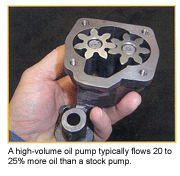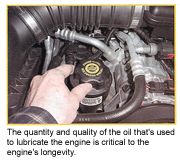The best way to get to the bottom of this subject is to go right to the heart of the engine’s lubrication system and start with the oil pump. The oil pump’s job is to suck oil in from the crankcase and push it through the filter and oil galleries to the crankshaft and camshaft bearings. The steady flow of oil supports, lubricates and cools the bearings. As it moves up through the rest of the engine, it also lubricates the camshaft and valvetrain components, and fills the hydraulic lifters or cam followers to eliminate valve lash. Oil splash from the crankshaft also cools and lubricates the pistons and cylinders.
The oil pump by itself doesn’t create oil pressure. It only pushes oil from one place to another. It’s a positive displacement pump that moves oil as it turns. So as long as the oil encounters no resistance, the pump creates no pressure. But oil does encounter resistance as it flows through the filter, narrow oil galleries and bearings. Oil is an incompressible liquid, so as resistance builds so does oil pressure.
Temperature is also a factor. The viscosity of oil changes with temperature. Hot oil is much thinner than cold oil. Consequently, oil pressure is higher when the oil is cold because it is thicker and harder to pump through the engine.
 When the engine is running and the pump is working hard to push oil through the system, some means of controlling pressure must be used to prevent too much pressure from building up in the lines and filter. A spring-loaded “pressure relief valve” in the oil pump (or next to the pump) opens when pressure exceeds a certain limit (typically 50 to 60 psi) and either reroutes oil back into the pump’s inlet or the oil pan. This prevents a dangerous buildup of pressure that could rupture the oil filter or blow out press-fit oil plugs.
When the engine is running and the pump is working hard to push oil through the system, some means of controlling pressure must be used to prevent too much pressure from building up in the lines and filter. A spring-loaded “pressure relief valve” in the oil pump (or next to the pump) opens when pressure exceeds a certain limit (typically 50 to 60 psi) and either reroutes oil back into the pump’s inlet or the oil pan. This prevents a dangerous buildup of pressure that could rupture the oil filter or blow out press-fit oil plugs.
At idle, most oil pumps do not produce enough flow to force open the relief valve. Oil pumps that are camshaft-driven only turn at half engine speed so output isn’t a lot at idle and low rpm. Even pumps that are crankshaft-driven and turn at engine speed (or double engine speed in a few instances) don’t pump enough oil to overcome the relief valve spring. The relief valve generally comes into play only at higher rpm when the pump’s output pushes more oil into the system than it can handle. Then the relief valve opens to vent oil and limit maximum oil pressure until engine returns to idle or a lower rpm.
Vehicle manufacturers have traditionally recommended a minimum of 10 psi of oil pressure for every 1,000 rpm of engine speed. Using these numbers, most stock engines don’t need any more than 50 to 60 psi of oil pressure. With tighter bearing clearances, pressure goes up, requiring less flow from the pump and less parasitic horsepower loss to drive the oil pump.
In racing applications, the old school of thought was that more oil pressure was needed to keep the engine lubed. That’s true if bearing clearances are increased over stock. But most performance engine builders today reduce bearing clearances so less oil flow is needed to maintain adequate oil pressure. This approach increases the horsepower output because less power is needed to drive the pump at high rpm.
According to various sources, a stock oil pump is usually more than adequate for modified stock block performance engines. Even NASCAR engines typically run with no more than 50 psi of oil pressure at 9,000 rpm.
WEAK PUMPS AND OIL PRESSURE PROBLEMS
If, for any reason, the oil pump can’t deliver its normal dose of oil, it’s bad news for the engine. An oil pump failure is just as bad as cardiac arrest because the results are almost always fatal. Loss of oil pressure means loss of the protective oil film between the bearings and their journals. With no oil to keep the surfaces apart, the bearings wipe and fail.
 A worn oil pump can’t deliver the same volume of oil as a pump with normal clearances. With less flow, there’s less oil pressure, less oil to maintain the oil film in the bearings and less cooling for the bearings. Under heavy load or at idle, there may not be enough oil flow to keep the bearings adequately lubed. The result is wiped bearings and engine failure.
A worn oil pump can’t deliver the same volume of oil as a pump with normal clearances. With less flow, there’s less oil pressure, less oil to maintain the oil film in the bearings and less cooling for the bearings. Under heavy load or at idle, there may not be enough oil flow to keep the bearings adequately lubed. The result is wiped bearings and engine failure.
Oil pumps experience wear over time because they are the only internal engine component that runs on unfiltered oil. Think about it. The filter protects the bearings and other internal engine parts by trapping wear particles and debris that end up in the crankcase. But the filter provides no protection whatsoever for the pump because the filter is located after the pump. The oil pump just sucks up whatever is in the crankcase and pushes it along to the filter. The only protection for the pump is a screen at the end of the pickup tube. The screen can stop big chunks of debris but little else. Some pickups even have slits that allow cold oil to bypass the screen when the engine is first started, so if there’s any junk in the oil it will be sucked right into the pump.
Pump failure can occur if anything large enough to jam the gears or rotors enters the pump. This includes metallic debris from bearings or castings, gasket or seal debris, shot peening remnants, glass beads from bead blasting, or anything else that doesn’t belong in the crankcase.
With twin-gear pumps, a foreign object that enters the pump can lodge between the close-fitting gears or the gears and housing causing the pump to lock up. Once the gears stop turning, something has to give. Usually the pump shaft twists or shears off. Sometimes a pump seizure tears up the teeth on the camshaft or distributor drive gears, depending on how the pump is driven. With front-mounted, rotor-style pumps, debris usually won’t lock up the pump because it’s driven directly off the crankshaft, but it can damage or destroy the rotors.
Even if a pump doesn’t fail, it loses efficiency as it wears. Scratches and wear in the gears and pump housing increase clearances and reduce pumping efficiency. The result is a gradual loss of oil flow and oil pressure.
HIGH VOLUME & HIGH PRESSURE PUMPS
In applications where more oil flow is desired either to increase oil flow and pressure for better bearing lubrication and cooling, an oil pump with longer or larger gears may be installed. The physically larger surface area of the gears pushes more oil through the pump at the same rpm than a stock pump. A high-volume oil pump typically flows 20 to 25% more oil than a stock pump. The increase in oil flow produces an increase in oil pressure at idle, which helps compensate for increased bearing clearances. Consequently, some people may install a high-volume pump in a high-mileage engine in an attempt to restore normal oil pressure. But, the only real cure for low oil pressure is to replace worn bearings and restore normal clearances.
High-pressure oil pumps are another option. A high-pressure pump contains a stiffer relief valve spring that doesn’t open until a higher pressure is reached (75 psi or higher). The actual flow rate of a high-pressure pump may be no different than a stock pump, or it may be higher if longer gears are used. Either way, the pump will increase the system oil pressure reading at high rpm when the pump is working hard, but it won’t have any effect on idle pressure when the pump is turning slowly.
A high-volume or high-pressure oil pump may be recommended in engines where bearing clearances are looser than normal, in engines where an auxiliary external oil cooler has been added to improve oil cooling and in racing engines where an oil accumulator has been installed.
OIL PUMP REPLACEMENT
Worn pumps obviously need to be replaced. But so do oil pumps in engines that have experienced a bearing failure or any other kind of internal problem that has put debris into the crankcase.
Another item that should always be replaced (but often isn’t) when changing an oil pump is the pickup tube and screen. Pickups are difficult to clean and can hide debris that may damage a new pump or the engine. You may think you’ve cleaned the pickup tube, but enough gunk could still be lurking inside to cause problems later on.
The pickup tube should be installed so it’s located no less than 3/8-inch above the floor of the oil pan (to allow good intake flow), and no more than 1/2-inch above the floor so that it doesn’t run out of oil in a sharp turn and suck air.
When installing a new oil pump, fill the pump cavity with oil. This will prime it and reduce the risk of a dry start. Do not use grease or assembly lube. In the case of front-mounted oil pumps inside the timing cover, the pump rotors can be coated with heavy oil, such as 50W or even gear oil, to keep the pump primed.
On older engines with distributor-driven oil pumps, the engine can be primed by using a drill to spin the oil pump shaft through the distributor hole. But on engines with no distributor or those with oil pumps inside the front cover, this isn’t possible. Feeding pressurized oil into the main oil gallery through the oil pressure sending unit fitting will route oil to all the critical areas inside the engine and eliminate the risk of scuffing the bearings when it’s first started.
MOTOR OIL
The quantity and quality of the oil that’s used to lubricate the engine is also critical to the engine’s longevity. Follow the viscosity recommendations in the vehicle owner’s manual. Most vehicles today are factory-filled with 5W-30 because it improves cold starting, fuel economy and allows the oil to reach critical upper valvetrain components in overhead cam engines more quickly than heavier viscosity oils.
Most vehicle manufacturers also approve 10W-30 for year-round driving. Other popular viscosities include 10W-40 and 20W-50, which are often used in older, high-mileage engines to provide extra high-temperature protection during hot weather (20W-50, however, is not recommended for cold weather because it is too thick). Straight weight oils are not recommended in late-model engines.
Synthetic oils and synthetic-blends are also a good upgrade, but obviously cost more than conventional motor oils. Even so, a synthetic may be required in some high-output engines (Mercedes-Benz, for example) or turbocharged engines to improve durability.
Synthetics hold up better at high temperature than conventional motor oils, and also flow better when cold. The upper limit for most mineral-based oils is about 250 to 300
